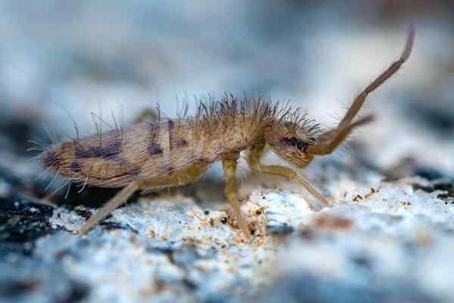What Spotting Springtails Can Say About Your Houston Home
Have you encountered tiny gray-looking insects, congregating in large numbers, in moist areas of your home? Do they spring away from you or, worse, spring up into your face, when you look at them closely? If so, you might be wondering what they are. Are they fleas? Do they bite? Are they dangerous? Today we are exploring springtails, what they are, and what it might mean if you are seeing them inside your Houston home.
The Anatomy Of A Springtail
Springtails are fascinating creatures. Some are smaller than the head of a pin. Springtails measure from 1-10 millimeter in length, yet they can jump, or spring, six inches into the air. That would be like a human being standing next to the Eiffel Tower and springing up and over it, without even getting a running start!
Sometimes springtails are mistaken for fleas, but these two creatures are very different. Fleas are dark reddish-brown while Houston-area springtails are usually white or gray. Springtails can't jump as far as fleas (up to 13 inches), Springtails have antennae, and springtails do not bite people. Furthermore, springtails aren't even insects.
Springtails are a species of hexapod which are closely related to insects. They have soft bodies and a tail-like appendage called a furcular that is kept tucked underneath their abdomens. When a springtail senses danger, this appendage is released and they are sprung up into the air. This spring-like "tail" is what gives it its name.
Are Springtails Dangerous?
Unlike fleas, which are capable of biting humans, spreading diseases, and driving people and animals crazy, springtails are mostly harmless. Springtails do not bite. They do not contaminate foods. They do not put off any odor. And they won't stain belongings. But they can be disturbing to encounter inside a home and they can be an indicator that your home has moisture issues.
How Springtails Get Into Homes
Outside, springtails can be found in areas of organic matter where moisture levels are high. Some places you might find springtails include underneath leaf piles, under mulch, in woodpiles, under logs, around flower pots, in rain gutters, and near pools or hot tubs. Springtails are so small, in one square meter of soil there may be over 10,000 of them.
If springtails are up against the foundation of a home, and the weather becomes too dry or too hot (or both) they can make their way in through gaps and cracks in the foundation. They can get in underneath doors that do not have effective door sweeps. And they can crawl in through gaps around utility pipes or be carried inside with potted plants.
Since these creatures need a lot of moisture to survive, springtails inside homes are usually found underneath bathtubs or sinks, in humid laundry rooms or kitchens, around plumbing pipes, behind basement walls, in crawl spaces, or in any other area where humidity is high. They will also get inside wet or moldy furniture or bedding.
What Does It Mean When Springtails Get Inside?
While springtails aren't dangerous to humans or possessions, they can be an indication of moisture issues in your home that can lead to many problems.
If springtails are getting in, then other pests can get in as well. Pests such as cockroaches, ants, spiders, and rodents will take advantage of water-damaged areas to get into homes. And, once inside, these creatures can spread diseases, contaminate food sources, destroy property, and more.
If springtails are getting in, then moisture is getting in as well. If wood is wet and rotting, there could be holes forming where the weather can get in and heat or cold air can escape your home. This can affect heating/cooling costs.
If springtails are getting in, then there is water-damaged wood. Where there is water-damaged wood, there can be mold and mildew, which can create even more health problems.
Springtail Prevention Tips
If you would rather not have these tiny springing creatures invading your home, there are a number of things you can do to try to keep them out.
Reduce moisture outside by cutting back vegetation from your outer walls and letting the sun and air dry the area around your foundation.
Reduce moisture inside by using fans and/or dehumidifiers in humid or moist areas of your home.
Seal up gaps and cracks in your foundation.
Install door sweeps under any doors leading outside.
Ventilate crawl spaces to keep them dry.
Check potted plants for springtails before bringing them inside.
Enlist the help of Modern Pest Control
If you would like an easy solution to getting springtails out of your home and keeping them out, contact the pest professionals here at Modern Pest Control. Reach out to us for details. We are standing by to help.

